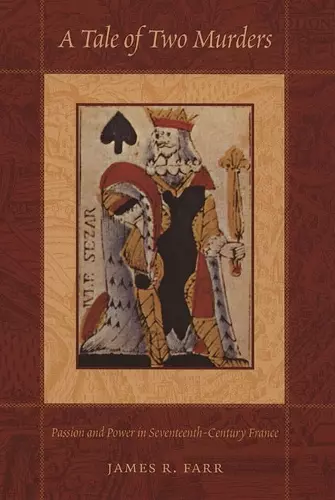A Tale of Two Murders
Passion and Power in Seventeenth-Century France
Format:Hardback
Publisher:Duke University Press
Published:28th Sep '05
Currently unavailable, and unfortunately no date known when it will be back

A compelling account of a 17th-century murder mystery and a well-researched scholarly work that explores the dynamics of power, justice, and law in Louis XIII's France
The 'Giroux affair' was a maelstrom of intrigue, encompassing daggers, poison, adultery, arch-enemies, servants and royalty, and legal proceedings that reached to the pinnacle of seventeenth-century French society. This book reveals the Giroux affair as not only a riveting murder mystery but also a point of entry into the dynamics of power.As scandalous as any modern-day celebrity murder trial, the “Giroux affair” was a maelstrom of intrigue, encompassing daggers, poison, adultery, archenemies, servants, royalty, and legal proceedings that reached the pinnacle of seventeenth-century French society. In 1638 Philippe Giroux, a judge in the highest royal court of Burgundy, allegedly murdered his equally powerful cousin, Pierre Baillet, and Baillet’s valet, Philibert Neugot. The murders were all the more shocking because they were surrounded by accusations (particularly that Giroux had been carrying on a passionate affair with Baillet’s wife), conspiracy theories (including allegations that Giroux tried to poison his mother-in-law), and unexplained deaths (Giroux’s wife and her physician died under suspicious circumstances). The trial lasted from 1639 until 1643 and came to involve many of the most distinguished and influential men in France, among them the prince of Condé, Henri II Bourbon; the prime minister, Cardinal Richelieu; and King Louis XIII.
James R. Farr reveals the Giroux affair not only as a riveting murder mystery but also as an illuminating point of entry into the dynamics of power, justice, and law in seventeenth-century France. Drawing on the voluminous trial records, Farr uses Giroux’s experience in the court system to trace the mechanisms of power—both the formal power vested by law in judicial officials and the informal power exerted by the nobility through patron-client relationships. He does not take a position on Giroux’s guilt or innocence. Instead, he allows readers to draw their own conclusions about who did what to whom on that ill-fated evening in 1638.
“Dazzling beauty, spousal abuse, passionate love, wanton covetousness, lust, conspiracy, poison, murder, vengeance: what an engaging surprise to discover that one of America’s foremost scholars of early modern European society, James R. Farr, is also a beguiling storyteller. A riveting drama, his book is at the same time a masterful analysis of emotion and affect, rites and rituals, elite formation and reproduction, family and lineage strategies, gender construction, the discourse and practice of the law, political culture, relations of domination and subordination, the tensions between center and periphery, and the myriad ways in which power worked in seventeenth-century France.”—Steven Laurence Kaplan, author of The Bakers of Paris and the Bread Question, 1700–1775
“James R. Farr has produced a terrific work of historical research, a book that offers both compelling narrative and suggestive analyses. A Tale of Two Murders addresses basic questions about how early modern society functioned, and it should interest specialists and non-specialists alike.”—Jonathan Dewald, author of Aristocratic Experience and the Origins of Modern Culture: France, 1570–1715
“A Tale of Two Murders is … riveting and readable, equally appropriate for an audience of university students or general readers.” -- Brian Sandberg * Renaissance Quarterly *
“Combining a gripping narrative with keen analysis, Farr uses this case to shed light on patronage and the pursuit of power among the seventeenth-century French nobility.” -- Jeffrey R. Watt, * Sixteenth Century Journal *
“In my experience, Farr’s book is a fine teaching tool. Wrapped in taut suspense, readers are gripped by indecision; guilty, not guilty; could be, maybe not. Adopting a smart strategy, he does not take a stand for or against the Giroux verdict (1643), so students may be asked to summarize evidence on both sides—reason about it—and offer verdicts of their own. A compelling historical narrative based on careful scholarship, this book is a valuable addition to studies of early modern France.” -- Sarah Hanley * American Historical Review *
“The best micro-histories manage to convey the texture of a vanished culture and to define and amplify the basic issues, concerns, and imperatives that infused the society in which the highlighted events unfolded. Farr’s engrossing study, A Tale of Two Murders, delivers those insights in spades.” -- Jay M. Smith * Journal of Interdisciplinary History *
ISBN: 9780822334590
Dimensions: unknown
Weight: 494g
240 pages